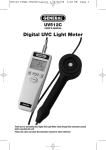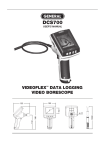Download NGD7201 Manual 052808 FINAL - General Tools And Instruments
Transcript
GAS LEAK DETECTOR Specifications subject to change without notice ©2008 GENERAL TOOLS & INSTRUMENTS™ NOTICE - WE ARE NOT RESPONSIBLE FOR TYPOGRAPHICAL ERRORS. MAN#NGD7201 05/08 NGD7201 User’s Manual e-mail: [email protected] www.generaltools.com GENERAL TOOLS & INSTRUMENTS™ 80 White Street New York, NY 10013-3567 PHONE (212) 431-6100 FAX (212) 431-6499 TOLL FREE (800) 697-8665 USER’S MANUAL NGD7201 This latest handheld gas leak detector features the following functions: DIAGRAM: Sensor Cap F E AT U R E S : • Detects methane and propane gas • Quickly pinpoint gas leaks • Automatically calibrate when power is on • Auto power off to save battery life • 60 seconds warm-up time • Response Time less than 10 seconds • 5 level LED leak alarm • Over 440 mm long flexible probe • Built in earphone jack • Mute function S P E C I F I C AT I O N S : • Sensor: Semiconductor • Response Time: < 10 seconds • Warm-up Time: < 60 seconds • Operation Temp. Range: -5° to 45°C • Power OFF: 10 minutes from power on • Power Source: 4 “AA” batteries (alkaline suggested) or “9V” adaptor • Battery Life: 14 hours (continuous) • Minimum battery voltage: 4.8V • Probe Length: 17.5" (447 mm) • Size: 6.9" x 2.8" x 1.5" (175 x 70 x 38 mm) • Indicator: Intermittent beep (Acoustic) / LED (Visual) S P E C I F I C AT I O N TA B L E : Filter included for high discrimination Advantage 40 ppm (Propane) Sensitivity Methane: 120 to 1920 ppm Propane: 40 to 640 ppm Range Flexible Probe Earphone Jack (Dia.: 3.5 mm) Indicator LED Adaptor Jack “ON/OFF” Key (Dia. outer: 4 mm/ inner: 1.3 mm) Mute Slide Switch Methane 5 level LED Propane 5 level LED I N D I C AT O R : Please be reminded that the left methane number isn't equal to the right propane number. So, make sure what gas you measured, then read the correct corresponding side value. Power “ON” & Batt. “OK” LED Batt. “LOW” LED Sensor “Ready” LED M E A S U R E M E N T O P E R AT I O N : 1. Power ON/OFF Press the “ON/OFF” key for more than 0.2 second to turn the meter on. While the meter is on and there is enough electrical power the Batt. “OK” LED will stay on. MAINTENANCE: 1. If silicone vapors settle onto the sensor’s surface, the sensor will be coated. So, avoid exposure where silicone adhesives, hair grooming materials and silicone rubber/putty may be present. To ensure the accuracy, users must perform the warm-up period in clean air. 2. High-density exposure to corrosive materials such as H2S, SOx, Cl2, HCl, etc. may cause corrosion or breakage of the lead wires or heater material. Press the “ON/OFF” key again to turn the meter off. The meter automatically turns off in 10 minutes. 2. Warm-up Status While the meter is powered on but “Ready” LED is off, it means the sensor is under warm-up process. The warm-up time is less than 60 seconds. While “Ready” LED is on, it means the meter is ready to measure. During this phase, a special compensating circuit automatically limits the effect of environmental change. Even when you turn the meter off for a short time and turn it back on again, it always needs 60 seconds to warm up. 3. Mute function The meter beeps every one second to ensure the meter is in normal working status. The “beep” frequency will speed up as the detected gas concentration becomes higher. When the user uses the earphone, the meter will automatically mute, but the user can hear the beeping through the earphone. When the user is not using the earphone, the user can mute the beeping by switching the mute to the “ON” position. 4. Leakage Checking Move the sensor toward the pipe, slowly sliding the sensor along the pipe. Repeat the procedure on the other side of the pipe. When the sensor is near a leak, the LED will light up and the beep frequency will increase. It takes at least 2 minutes of waiting for the sensor to recover after removing the sensor from the leak point. BAT T E RY R E P L A C E M E N T: When the battery “LOW” LED is on, it is suggested to change the batteries to ensure the units accuracy. Open the battery compartment of the meter on the rear side and replace with 4 “AA” batteries. TROUBLESHOOTING: Meter does not turn on a) Make sure the time of pressing the “ON/OFF” key is more than 200 mS. b) Check that the batteries are in place, with good contact and correct polarity. c) Replace with a new battery and try again. “Ready” LED isn’t on after 60 seconds warm-up a) Check that the sensor is making good contact. 3. Sensor drift may occur when the sensor is contaminated by alkaline metals, especially salt water sprays. 4. Sensor drift may occur due to soaking or splashing the sensor with water. 5. If water freezes on the sensing surface, the sensor may crack and alter characteristics. 6. This meter is required to operate under around 21% ambient oxygen environment in order to function properly. This meter cannot work well in a zero or low oxygen atmosphere. Situations which must be avoided 1. Light condensation under indoor usage should not be a problem for the sensor. However, if water condenses on the sensor’s surface for a while, the sensor characteristics may still drift. 2. Sensor performance may be also affected if exposed to a high density gas for a long time, regardless of the powering condition. 3. When meter is off for a long time, the sensor may show a drift in resistance according to the storage environment. So, the meter should be stored in a sealed bag with clean air. NOTE: While the unpowered time becomes longer, a longer warm-up period is required to stabilize the sensor before usage. Turn on the meter occasionally to make the accumulative warm-up time shorter. 4. Regardless of the powering condition, if the sensor is exposed to extreme conditions such as very high humidity, extreme temperatures or high contamination levels for a long period of time, the sensor performance will be adversely affected.






